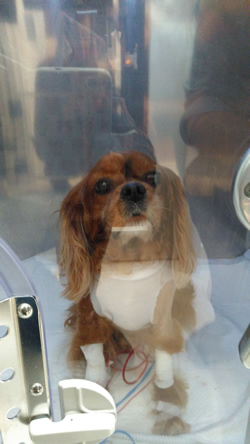Cavalier Argos,
a Man's best companion

A Cavalier King Charles Spaniel consulting the Vet
NEWS :: SCIENCE
Man himself cannot express love and humility by external signs, so plainly as does a dog, when with drooping ears, hanging lips, flexuous body, and wagging tail, he meets his beloved master.
Charles Darwin
Dogs & sciences
Mystery of Chernobyl's blue wild dogs solved: The real reason canines changed color
Three dogs living at Chernobyl were recently spotted with bright blue fur, sparking a storm of social media speculation that radiation had caused the unusual coloring.
Since 2017, the Dogs of Chernobyl program has cared for roughly 700 dogs living within the 18-square-mile exclusion zone, providing food and medical attention each year.
These animals are descendants of pets abandoned when residents were evacuated following the 1986 Chernobyl nuclear disaster, one of history’s most catastrophic nuclear accidents.
...read the full article in The Daily Mail
Please also help the veterinarians caring for the Chernobyl dogs
Alternatives to spay and neutering to care for our dogs well being
Innovative transcatheter edge-to-edge mitral valve repair (TEER)
Non intrusive heart surgery to repair the mitral valve is available since January 2020 at Colorado State University at Denver with Prof Christopher Orton's Cardiology team (see attached information)
And most recently, since December 2022, in France at Hopia.fr with Dr Sabine Bozon's Cardiology team;
as well as in the United Kingdom at Willows Veterinary Centre & referral service with Dr Simon Swift's Cardiology team
Dog Neutering contoversy & the latest scientific findings
Read also:
Assisting Decision-Making on Age of Neutering for 35 Breeds of Dogs: Associated Joint Disorders, Cancers, and Urinary Incontinence
Long term effects of Neutering a Dog
Evaluating benefits and risks of neutering a dog
RVC Dog & Puppy Neutering review in progress
Hormone sparing sterilization
Research for sterilization via a pill at 600Millions.org
Innovative non invasive procedure to treat heart failure in dogs
Willows has launched a ground-breaking cardiology procedure for dogs only previously used in human healthcare.
The minimally invasive transeptal puncture (TSP) now being performed by our world-renowned cardiology team avoids opening the chest or heart and involves using minimally invasive techniques to pass a thin flexible tube from the right atrium through to the left-hand side of the heart.
... full notice at Willows
Hearts in his hands: mitral valve repair in the UK
Professor Daniel Brockman is the director of the Cardiothoracic Surgery Service at the Royal Veterinary College (RVC) and one of very few people in the world capable of performing mitral valve repair surgery on canine patients.
...
“There are thousands of dogs who would benefit from this, but due to the challenging nature of the surgery, the multidisciplinary approach required and the costs involved, very few can access it across the globe. There are maybe two or three active mitral valve repair programmes in Japan, one in France, one in Austria, and two in the UK. Ours is probably the busiest of such programmes outside Japan.”
... full article here
Veterinary student, Maciej Szczepański, builds 3D printed prostheses for injured dogs
... more information at TheFirstNews.com and at Wimba.vet
Student design may lead to heart treatment for small dogs
Dr. Romain Pariaut, associate professor of cardiology at Cornell’s College of Veterinary Medicine, is collaborating with a team of biomedical engineering students in the Master of Engineering Program to find a cheap, less invasive and effective solution to mitral valve disease.
... full article here
Welfare problems of flat-faced dogs (English & French Bulldogs, Pugs, Pekingese, Cavalier King Charles Spaniel) - can we ever solve them?
This APDAWG [All-party Parliamentary Dog Advisory Welfare Group] meeting explored brachycephalic welfare issues and the challenges we face when trying to improve the ‘wicked problem’ of brachycephalic dog welfare. The meeting promoted positive actions to improve the overall welfare of brachycephalic dogs.
Dr Christopher Orton of Colorado State University veterinary team performs first-ever heart valve procedure on schnauzer
What began as an educational trip ended up with a momentous medical first for Colorado State University.
During the first week of January, a team led by Dr. Chris Orton, veterinary cardiothoracic surgeon, traveled to China to meet with leaders from the Shanghai Hanyu Medical Technology Company. The CSU team planned to learn more about a new device to treat dogs with mitral regurgitation, a leak of the valve between the left ventricle and the left atrium of the heart, and a common condition in older dogs.
Following initial meetings, the CSU team was asked to perform a procedure using the new device on a 7-year-old miniature schnauzer named Datou, or Big Head.
“He was in an advanced stage of heart failure and had perhaps a few months to live,” said Orton, also a professor of clinical sciences at CSU.
... read the article here
Preliminary Outcome of a Novel Edge-to-Edge Closure Device to Manage Mitral Regurgitation in Dogs
Anuloplastia mitral en Nicolás, primer paciente peruano operado en Japón
Why are so many of our pets overweight?
When I looked at my appointment book for the day, I thought something must be wrong. Someone who worked in the fitness industry was bringing his cat in to the Tufts Obesity Clinic for Animals. Did he confuse us for a different kind of weight management clinic? Is he looking to get muscle on his cat or maybe kitty protein shakes?
I was utterly surprised when I called for my appointment in the lobby and an athletic man stood up with an almost 20-pound cat! I asked if I could speak bluntly with him. Why does someone who clearly knows a lot about keeping healthy need to bring his cat to a veterinary nutritionist? What would he say if the cat was one of the people he helps to keep fit every day? Our conversation then went something like this…
“Well, I’d tell her, suck it up, buttercup. Do some kitty pushups and no more treats!”
“Well, I have to ask, then, what’s stopping you from doing this with your cat?”
With a worried look of guilt on his face, he replied, “Well, Dr. Linder, I mean… she meows at me…”
This was the moment I realized that I was treating pet obesity all wrong. I needed to focus less on the pet and more on the relationship between people and their pets. That’s what’s literally cutting the lives short of the dogs and cats we love so much.
... read in full this article in The Conversation
Dr. Borgarelli, from Virginia-Maryland College of Veterinary Medice, reports successful replacement of mitral valve chords using the Harpoon TSD-5 device.
M. Borgarelli, O. Lanz, N. Pavlisko, J.A. Abbott, G. Menciotti, M. Aherne, S.M. Lahmers, K.K. Lahmers, J.S. Gammie. J. Vet. Cardiol. May 2017.
Quote: Objective: Mitral valve (MV) regurgitation due to degenerative MV disease is the leading cause of cardiac death in dogs. We carried out preliminary experiments to determine the feasibility and short-term effects of beating-heart MV repair using an expanded polytetrafluorethylene (ePTFE) chordal implantation device (Harpoon TSD-5) in dogs. Animals: This study involved six healthy purpose-bred Beagles (weight range 8.9–11.4 kg). Material and Methods: Following a mini-thoracotomy performed under general anesthesia, the TSD-5 was used to place 1 or 2 artificial ePTFE cords on the anterior MV leaflet or the posterior MV leaflet via a left-ventricular transapical approach. The procedure was guided and monitored by transesophageal echocardiography. Postoperative antithrombotic treatment consisted of clopidogrel or a combination of clopidogrel and apixaban. Dogs were serially evaluated by transthoracic echocardiography at day 1, 7, 14, 21, and 30. The hearts were then examined for evaluation of tissues reactions and to detect signs of endothelialization. Results: One or two chords were successfully implanted in five dogs. Four dogs completed the 30 days follow-up. One dog died intra-operatively because of aortic perforation. One dog died early post-operatively from a hemorrhagic pleural effusion attributed to overly aggressive antithrombotic treatment. One dog developed a thrombus surrounding both the knot and the synthetic cord. Postmortem exam confirmed secure placement of ePTFE knots in the mitral leaflets in all dogs and the presence of endothelialization of the knots and chords. Conclusions: This pilot study has demonstrated feasibility of using the Harpoon TSD-5 device to place and anchor ePTFE artificial chords to the MV of small dogs and that endothelialization of the synthetic cord and knots can start within 30 days.
...more in CavalierHealth.org
Read also:
Minimally Invasive Mitral Valve Repair in Dogs with Chronic Mitral Valve Disease (CVD) ... [+]
Researchers study heart disease in Cavalier King Charles Spaniels using high-tech 3-D imaging ... [+]
Veterinary college study and pioneering database tackle most common heart disease in dogs ... [+]
Outstanding canine open-heart surgery succeeds
Last April, Dylan Raskin’s Japanese Chin, Esme, was diagnosed with mitral valve
regurgitation, a fatal condition that causes backflow of blood in the
heart’s chambers. Though veterinarians initially treated the condition
with pills, the dog’s heart failure became worse, leading specialists
to predict just a few more months of life for Esme.
Esme’s future now looks bright, as the Chin received a rare and successful
seven-hour open-heart surgery at Cornell’s Hospital for Animals Nov.
19 and was released with a healthy prognosis Nov. 26. The surgery was
conducted by (Dr
Masima UECHI's) a team of five Japanese veterinarians who
specialize in such heart surgeries, and led to some hefty medical bills,
including $22,000 to fly the surgical team to Ithaca and $10,000 in
hospital fees.
Raskin did research to find and contact the Japanese surgeons, and with
the help of two Cornell alumnae, the College of Veterinary Medicine
agreed to sponsor the procedure.

... more in Cornell
Chronicle [+]
Read also:
Man
turns to Cornell, spends last dollar to save dog ... [+]
'Miracle'
dog Esme doing well after upstate New York man spends $32,000 for life-saving
heart surgery ... [+]
Upstate
New York man raising $30,000 in attempt to save dog's life ... [+]
WCAX.COM
Local Vermont News, Weather and Sports-
Dog's
open-heart surgery opens doors for others ... [+]
Koffee
Kat
on Wheels hits the road ... [+]
Author
and Friend ... [+]
Esme lived well and full of energy -without medication- after his cardiac surgery by Dr Uechi in November 2014. Sadly, Esme died recently due to a pancreatic cancer (June 2017)
New premises for JASMINE as from May 2020

How smart are animals -except humans?
 This photo of me, Argos, was taken by my friends after my bypass heart surgery at Jasmine Veterinary Cardiovascular Medical Center in Japan,
(Monday 9th April 2018).
This photo of me, Argos, was taken by my friends after my bypass heart surgery at Jasmine Veterinary Cardiovascular Medical Center in Japan,
(Monday 9th April 2018).








